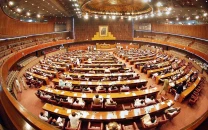Nuclear pre-emption after Geronimo
The history of Pakistan-India crises shows that India engages in chest-beating in moments of Pakistan’s weakness.

Nuclear pre-emption after Geronimo
Can Operation Geronimo serve as an ominous example and as a precedent for a scenario suggested at the Pentagon in 2008? How plausible are the recent Indian army and air chiefs’ assertions that they could replicate the American raid deep inside Pakistan to kill Osama bin Laden? In the extreme event of a pre-emptive strike, can Pakistan defend itself? These questions may sound paranoid but do arise if the implications of Operation Geronimo are stretched to the limit. The success of the raid may, mistakenly, embolden others to think that they could get away with something similar. That said, Pakistan’s foreign office and the GHQ have warned India of catastrophic consequences if it takes American action as a rule and ‘miscalculates’ Pakistan’s response. America was cautioned not to repeat such unilateralism. Let’s try to unfold the possibility of nuclear first-use and Pakistan’s capability.
We have one historic example which shows that nuclear installations are only destroyed in raids once the targeted country’s programme is in infancy and the aggressor is 100 per cent sure that there will be no credible retaliation. Let’s take the US first. If it had any wish to destroy Pakistan’s nuclear capability, it would have done so in the early 1980s. But Washington could not afford to attack for two reasons. One, it needed Pakistan in the so-called jihad against the erstwhile Soviet Union. Two, it wasn’t sure how many bombs Pakistan had.
America won’t pre-empt for three reasons. First, its relations with Pakistan are on the rocks but have not nose-dived. Second, Pakistan doesn’t constitute a proliferation concern and finally, it remains their major non-Nato ‘ally’.
Let’s assume, against conventional wisdom, that America decides to take advantage of Pakistan’s misperceived vulnerability. In the confusion following a hypothetical American strike on Pakistan’s nuclear assets or command infrastructure, Islamabad may wittingly, or unwittingly, retaliate thus, sparking a nuclear war beyond anyone’s control.
Let’s understand the possibility of Indian pre-emption. Pakistan has not formally declared its nuclear doctrine so we don’t know if it will use the nukes first. Though the nuclear facilities on both sides can generally be pinpointed, locations of actual nuclear weapons are not public. Since nuclear facilities of both India and Pakistan are vulnerable, they have a bilateral agreement not to attack these and Indians don’t bat an eyelid in exchanging the list of installations with Pakistan on January 1 every year.
Some fixed launch-sites of weapons on land can be targeted, but neither can guess the location of mobile delivery systems, which include air launched weapons and sea-based assets. Targeting the decision-makers is problematic too. We know where the nuclear decision-makers live in peacetime but it is anybody’s guess as to where they will reside in times of crisis or war. India is fast moving towards difficult-to-target submarine-based nuclear arsenal and will have assured second strike capability. After the test of slim Hatf-IX (Nasr), Pakistan may soon mutate it to develop a submarine platform. Hence, the threat of destruction will assuredly become mutual.
The history of Pakistan-India crises shows that India engages in chest-beating in moments of Pakistan’s weakness. Its air and army chiefs did so by suggesting that New Delhi retains the capability to copy the American raid in Abbottabad. Even if the capability is possible, can they be sure of starting a war without the risk of it escalating to a nuclear one?
Deterrence, like beauty, lies in the eyes of the aggressor and hubris on nuclear power is the last thing a nuclear state must exercise. No matter how many impregnable lines of defence any technology can break, the risk of a single weapon landing on the aggressors’ soil is too big to be taken. That’s probably why the radical pre-emptive strikes manifesto of Nato’s wizards fell out of favour and no one heard of it again.
Published in The Express Tribune, May 13th, 2011.



















COMMENTS
Comments are moderated and generally will be posted if they are on-topic and not abusive.
For more information, please see our Comments FAQ